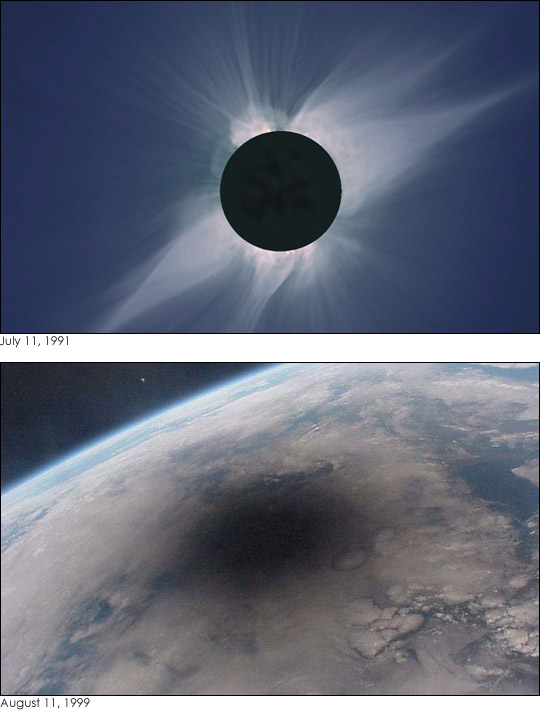


Like the beam of a flashlight in reverse, the Moon casts its shadow over the Earth when it moves in front of the Sun during a total solar eclipse. Within this shadow, which measures about 100 miles across, day becomes night for a few minutes as the Sun’s disk turns black surrounded by a glowing halo. The pair of images above shows two different perspectives on eclipses. The top photo shows the view of the Sun from Baja California during an eclipse on July 11, 1991, with the Moon sliding in front of the Sun. The bottom image is a reverse perspective: a view toward Earth from the perspective of space. During an eclipse, the Moon’s circular shadow slips across the Earth’s surface. The bottom image was taken by astronauts on the Mir Space Station during a total solar eclipse over Eastern Europe on August 11, 1999. Three total solar eclipses have occurred since 1999, and the next is on March 29, 2006. It will be visible along a narrow section of the Earth running from eastern Brazil, through Africa, and into Southwest Asia. A live Webcast of the eclipse will be available on NASA’s Eclipse in a Different Light Website.
Although total eclipses happen once every year or two, they are visible over such a small region that few people see more than one during their lifetimes. For most places on Earth, 360 years pass between total eclipses. Since eclipses are both locally rare and dramatic, they were viewed as an omen of doom by nearly all ancient cultures.
Over time, people realized that eclipses occur when the Moon moves between the Earth and the Sun. A total eclipse is possible because the Sun and the Moon appear to be the same size from the surface of the Earth. The Sun is 400 times larger than the Moon, but it is also 400 times farther away, so the Moon can block the Sun’s light entirely when the two are aligned. An eclipse begins at sunrise in one place and ends at sunset half way around the world. For example, the total solar eclipse on March 29, 2006, starts at sunrise over the eastern tip of Brazil and ends at sunset in western Mongolia. The total eclipse will be visible in a 100-mile-wide swath in between the two locations, with the greatest eclipse, when the Sun will be darkened longest, in southern Libya. A partial eclipse will be visible over a broader region. To see the track of the eclipse, visit NASA’s Eclipse Page.
Visit Eclipse in a Different Light for educational activities, more images, a live Webcast of the March 2006 eclipse, and articles about the history and science behind solar eclipses.
Eclipse photo, top, copyright Steve Albers, Dennis DiCicco, and Gary Emerson. Mir photo, bottom, copyright Centre National d’Etudes Spatiales (CNES).